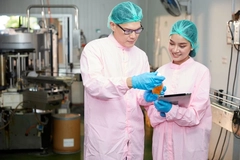Vitafoods Europe 2022: Ingredient shortages leave nutrition businesses marooned as freight shipments dry up

13 May 2022 --- Companies are scrambling to obtain the necessary ingredients for their products as supply chain issues, compounded by the Ukraine war and steeply rising inflation, threaten the industry. With companies rushing to get their hands on supplies, the crisis is exacerbated by spiraling costs and enormous challenges in finding freight transport.
NutritionInsight speaks to exhibitors from the show floor at Vitafoods Europe 2022 in Geneva, Switzerland, who explain why there are murkier waters behind the sparkling lights at the Palexpo this year.
“Prices have increased at least 50% to 60% with regard to transport,” says Dr. Christoph Heuberger, product manager at Lipoid. Due to the nature of the company’s materials, many of their items need to be shipped through air freight outside of Europe, with costs doubling compared to pre-covid, he adds.
“This is very frustrating. We went through two years of the pandemic, and everybody was so happy to pursue new product development projects,” Nexira’s marketing manager Julie Imperato, explains.
Now, however, “prices are rising on every front,” with the company’s purchasing department having to be vigilant on how to best source the ingredients and continuously try to find solutions.
 Companies depending on certain ingredients have little choice but to suffer the increasing costs.Big business pooling together
Companies depending on certain ingredients have little choice but to suffer the increasing costs.Big business pooling together
According to Heuberger, the problem with logistics appears to be marred with issues that don’t quite add up.
“When it comes to sea freight, we use reefers, but they seem difficult to find. They have not disappeared with COVID-19. They must be somewhere around the world, but it seems to be difficult to understand where they are.”
He suggests big companies have enough networks to get their hands on what they need, leaving smaller companies in the lurch.
“Prior to COVID-19, sea freight would take one month to go to South Korea. Now it takes two and a half months.”
Many supplement manufacturers also have products sitting idly, as they wait for key ingredients such as zinc, magnesium or preservatives that come from China, explains Britta Busch, key account manager for health and nutrition ingredients at Iprona.
“A lot of times products are sitting there ready to be processed but there is something missing in the whole recipe and they can’t proceed with manufacturing the goods.”
Limited options
In a bid to combat the issue, there has been a shift toward sourcing ingredients locally. However, the challenge remains on certain ingredients that are only sourced from one location. Citric acid, largely seen as an industry staple, has quadrupled in price from around US$3 to US$12, one source explains. Compounding the problem is that around 99% of it is sourced from China, leaving limited options.
“We have enough stocks to last us up to a year to 18 months. After that though, we don’t know,” the source shares.
Similarly, Imperato notes the company’s acacia fiber item is sourced from Africa with no alternative, meaning Nexira needs to purchase the ingredients and suffer the increased expenses. There has also been an observed delay in receiving the shipment to France.
“With this ingredient, we have no other choice. It has to grow in Africa, we cannot change that. Everyone is affected by this.” The market is marred with fragility and fierce competition in sourcing logistics.
The market is marred with fragility and fierce competition in sourcing logistics.
Question of availability
Though traditionally shipments and logistics have been organized in an orderly manner, the current picture is far more messy, underscores Busch. With the US being the company’s main market, the challenge does not lie just in price but in availability.
“It makes planning extremely difficult,” she says.
Usually, planning is done by season, but when interacting with customers to ask about orders, many simply say they cannot give an answer. There are times warehouses are full and times when they are completely empty, she continues.
“We even have the situation where we had to tell our customers there’s a plane leaving tomorrow. If you want your product to be on that plane, you have two hours to decide otherwise, it’s gone. That’s challenging. If you don’t take that slot, we don’t know when we’ll get the next one. That’s hard for us to face.”
“It requires a lot of resourcefulness.”
Uncertain future
Industry research has already revealed that brands in premium nutrition categories will have to work even harder to retain their customers as companies and consumers alike feel the onslaught of the supply chain crisis and inflation.
With consumers struggling between eating or heating their homes and companies implementing price hikes due to inflation, the question on how the market will shape up in the future remains unclear.
“The situation has to get better,” stresses Imperato.
By Andria Kades












